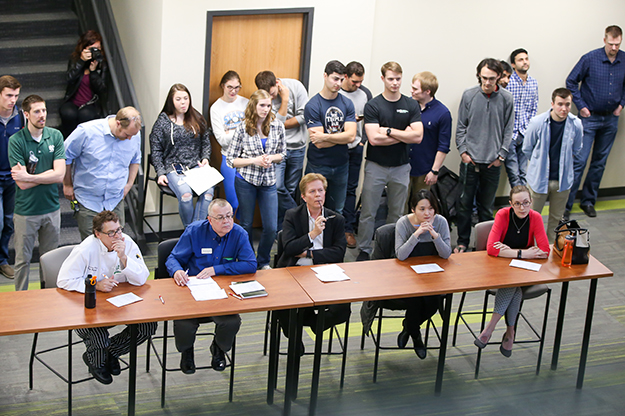‘BIG’ idea fosters big solution
Distill Nation wins final engineering challenge, delivering a viable project to purify water more cheaply

“Distill Nation,” a team of UND engineering students, took top honors in the final iteration of the BIG Challenge competition, held recently at the UND College of Engineering & Mines (CEM).
The team’s idea could bring clean water more cheaply to parts of the world that need it.
The team comprised the following members (in alphabetical order): Maggie Ahmann, sophomore, mechanical engineering; Bridget Heiland, sophomore, mechanical engineering; Mikaila Kringstad, sophomore, chemical engineering; and Annie Miles, freshman, mechanical engineering.
Miles said the object of Distill Nation’s BIG Challenge project was to research the most effective way to inexpensively help people purify water in cash-strapped areas with little available technology. The team’s proposed solution is a simple distillation process using readily available materials, including a quart-size water or juice bottle and a gallon-size milk jug
The prize: a $1,000 cash scholarship.
“Our aim was straightforward,” Miles. “We wanted a simple technology to provide clean water.”

Like-minded women
Miles, incoming president of the UND chapter of Engineers Without Borders, said that it was a truly enjoyable experience to collaborate with like-minded young women. Judges appreciated the team’s easy-to understand concept and their practical solution to a globally common problem—clean water.
In the narration for the team’s video—limited by competition rules to a maximum of three minutes—Miles stated: “We decided that instead of devising a large community wastewater treatment plant, we would provide a simple engineering process for individuals to make their own wastewater treatment with materials they likely have around.”
Hence Distill Nation’s wastewater-recovery system uses globally common plastic water bottles and larger milk jugs and takes advantage of the consistent availability of powerful sunlight prevalent in many Third World countries targeted by the project.
Creative thinking
From thinking about the future to solving the problems of today, the BIG (Big Ideas Gym) program is a new way for CEM students and others to imagine ideas and make them happen. And, along the way, win some cash.
“I love the idea of the Big Ideas Gym,” said UND President Mark Kennedy. “UND is the place where big ideas should come from. We’re taking on global challenges.”
UND Chemical Engineering Chair Brian Tande, who is director of CEM’s Jodsaas Center for Engineering Leadership and Entrepreneurship as well as director of the BIG Program, said this competition challenges students to develop real-world, practical solutions to pressing problems. The program was cooked up along with the newly created Collabortive Energy Complex, part of the CEM campus at UND.
“We wanted the Complex to have new interesting creative space that promoted collaboration and multidisciplinary projects,” said Tande. “It’s part of the overall mission of college is to get students to collaborate, to think creatively, and to do things beyond the traditional definition of engineering.”


